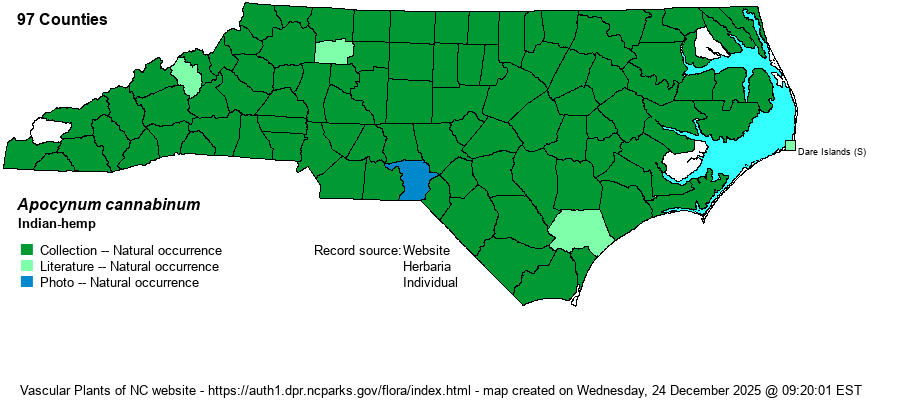| Author | L. | |
| Distribution | Occurs throughout the state, certainly found in all 100 counties, though known records lacking for a few, particularly in the extreme southwestern Mountains.
This is an abundant species across North America, from coast to coast and south to central FL and central TX. | |
| Abundance | Very common to abundant across the entire state, except "just" common in much of the Mountains. This is likely one of the more numerous native dicot species in the state. | |
| Habitat | This species favors open country of a great variety of habitats and soil moisture. It grows in abandoned fields, roadsides, powerline clearings, wooded margins, margins of thickets, and various grasslands. It is an old field succession species, often seen a few years after a field has been abandoned. |
| Phenology | Blooms from May to July, and fruits in September and October. | |
| Identification | This is a very familiar herbaceous species, often growing in dense stands or patches, on an erect stem with a few branches, to 3-4 feet tall. It has large numbers of opposite leaves, each elliptic to ovate, about 4 inches long and about 2 inches wide. It has large numbers of small flowers on each plant, from upper leaf axils. Each flower is quite small, barely 1/5-inch long, somewhat tubular and pale greenish or yellowish white to essentially white. The flowers are very fragrant and strongly attract bees and butterflies, which then attract naturalists and photographers! The plants often grow in patches 100 yards across in very dense stands, almost to the exclusion of other plant species. The plants have a milky sap, in case you would need to break off a branch or leaf at its base to check out this character. In the fall, the species has paired very slender pods that droop; each pod is about 6 inches long. Though the plants have fairly standard opposite leaves, the branches and stem are generally purple, another character (along with the milky sap) that should be helpful in identifying the species when not in bloom or fruit. | |
| Taxonomic Comments | Despite its huge range, there appear to be no recognized varieties or subspecies, at least accepted by Weakley (2018) in NC.
| |
| Other Common Name(s) | Dogbane, Hemp Dogbane, Prairie Dogbane. Though the genus Apocynum typically is called "dogbane" as a group common name, this species has been known as Indian Hemp/Indian-hemp for many decades, and the editors prefer to stick with this very familiar name. | |
| State Rank | S5 | |
| Global Rank | G5 | |
| State Status | | |
| US Status | | |
| USACE-agcp | FACU link |
| USACE-emp | FACU link |

